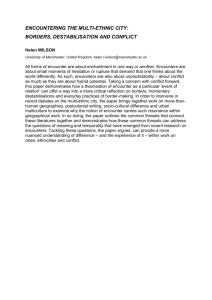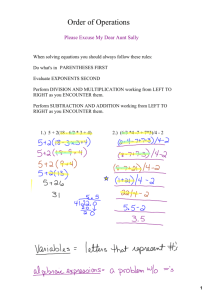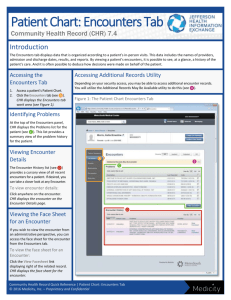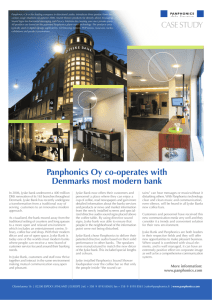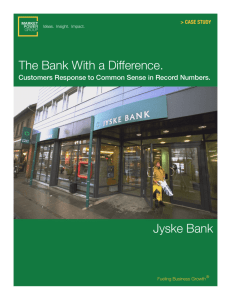1 Services Marketing and Customer Relationship Management
advertisement
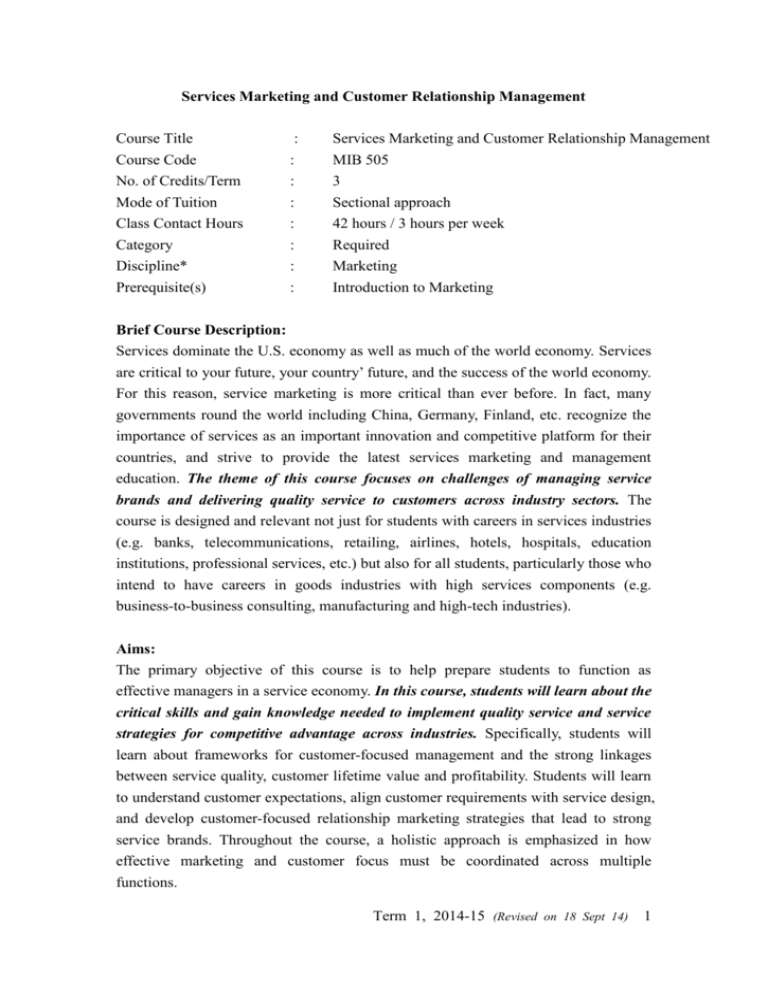
Services Marketing and Customer Relationship Management Course Title Course Code No. of Credits/Term Mode of Tuition Class Contact Hours Category Discipline* : : : : : : : Services Marketing and Customer Relationship Management MIB 505 3 Sectional approach 42 hours / 3 hours per week Required Marketing Prerequisite(s) : Introduction to Marketing Brief Course Description: Services dominate the U.S. economy as well as much of the world economy. Services are critical to your future, your country’ future, and the success of the world economy. For this reason, service marketing is more critical than ever before. In fact, many governments round the world including China, Germany, Finland, etc. recognize the importance of services as an important innovation and competitive platform for their countries, and strive to provide the latest services marketing and management education. The theme of this course focuses on challenges of managing service brands and delivering quality service to customers across industry sectors. The course is designed and relevant not just for students with careers in services industries (e.g. banks, telecommunications, retailing, airlines, hotels, hospitals, education institutions, professional services, etc.) but also for all students, particularly those who intend to have careers in goods industries with high services components (e.g. business-to-business consulting, manufacturing and high-tech industries). Aims: The primary objective of this course is to help prepare students to function as effective managers in a service economy. In this course, students will learn about the critical skills and gain knowledge needed to implement quality service and service strategies for competitive advantage across industries. Specifically, students will learn about frameworks for customer-focused management and the strong linkages between service quality, customer lifetime value and profitability. Students will learn to understand customer expectations, align customer requirements with service design, and develop customer-focused relationship marketing strategies that lead to strong service brands. Throughout the course, a holistic approach is emphasized in how effective marketing and customer focus must be coordinated across multiple functions. Term 1, 2014-15 (Revised on 18 Sept 14) 1 Indicative Content: Understand Service Products, Customer Expectations, Satisfaction and the Gap Model Recognize characteristics of service, justify the requirement of a distinct approach to marketing of services, comprehend an organization’s service strategy using the Gaps Model of Service Quality Develop a Customer-Focus by locating the Customer Gap Identify factors that influence customer expectations of service, explain the potential gap between expected quality and actual/perceived quality that affects service satisfaction, identify service quality dimensions, illustrate how service encounters function as building blocks for customer perceptions Manage Customer Requirements by Customer Research and Relationship Building (Provider Gap 1: Listening Gap) Outline elements in an effective service marketing research program, analyzing customer research findings with reference to zones of tolerance, diagnosis profitability tiers with the aid of the customer pyramid tool, state different relationship development strategies, differentiate service recovery strategies Align with Customer Requirements by Service Design and Standards (Provider Gap 2: Design Gap) Distinguish different types of service innovation, present service blueprinting as a technique for service design, identify different types of customer-defined service standards, explain how physical evidences affect customer experience, recognize the strategic role of servicescape and guidelines for physical evidence strategy Match Customer Requirements by Delivering and Performing Services (Provider Gap 3: Service Performance Gap) Exemplify the role of service leadership and service culture with example, explain the critical boundary-spanning roles of service employees, present different strategies for delivering quality service through people, identify the critical roles of customers in service delivery, present different strategies for enhancing customer participation in service co-creation Manage Service Brand Promises by Integrated Communication and Value-based Pricing Strategies (Provider Gap 4: Communication Gap) Term 1, 2014-15 (Revised on 18 Sept 14) 2 Restate key service communication challenges, illustrate with examples for five categories of strategies to match service promises with delivery, explain why service prices are different for customers, present pricing strategies that link to four different types of value definitions Learning Outcomes: Upon completion of this course, students will be able to: 1. Effectively describe and utilize key service frameworks and concepts including the Gaps Model, the Service-Profit Chain, and the Service Quality measurement concepts to address problems commonly encountered in the marketing of services; 2. Efficiently apply service marketing research techniques to measure service quality and facilitate well-informed decisions being made leading to customer satisfaction and long-term success of the company; 3. Competently apply techniques for designing new services and improving existing services, utilize tools for recovering from a service failure, and construct an appropriate mix of integrated marketing communication strategies in building a service brand; and 4. Confidently become a perceptive consumer as well as an effective manager through understanding the complexities of service design, delivery, and communication. Teaching Method: Presumably, students learn best and retain the most through active participation in the learning process. Therefore, classroom sessions will consist of a mixture of short lectures, student discussions on assignments, case discussions, active learning exercises, and guest lectures. The intent is for students to demonstrate their understanding of course concepts. Thus, when appropriate, students should use services marketing concepts in their discussion to provide evidence of their knowledge and understanding of these concepts. Term 1, 2014-15 (Revised on 18 Sept 14) 3 Assessment Methods and Tasks: Assessment Methods/Tasks Weight Intended Learning Outcomes 1 Case studies 20% X Class participation and case discussion 10% X Individual assignment – Service Encounters Paper 15% X Group project – 25% 2 X 3 4 X X X X X X X X Service Design Blueprinting Report Oral Presentation Final exam 30% TOTAL 100% X X Course Materials: Required/Essential Readings Valarie A. Zeithaml, Mary Jo Bitner, and Dwayne Gremler, Services Marketing: Integrating Customer Focus across the Firm, sixth edition, McGraw-Hill, 2012. Case Studies Four cases – Jyske Bank (pp.572-590), JetBlue Airline (pp.591-607), Merrill Lynch Supernova (pp.516-536), and Zappo.com 2009 (pp.495-515) – can be found at the end of the Zeithaml, Bitner, and Gremler (2013) 6th edition textbook. Assigned Case Questions Case assignments are specifically designed for this class. The questions for each of the case studies, as stated on the next two pages, can be found in Course Related Link. Course Packs for Weekly Learning Activities There are 2 encounters for each weekly topic consisting of: mass lectures on Tuesdays and small-class tutorials on Thursdays. Accordingly, there are two types of course packages involved: a YELLOW pack of in-class learning activities for the Tuesday encounters; and a GREEN pack of tutorial learning activities for the Thursday encounters. Course Related Link Supplementary course materials including the syllabus, case questions, PPT slides, and other materials are posted on http://www.ln.edu.hk/mkt/courses/mib505 Term 1, 2014-15 (Revised on 18 Sept 14) 4 Measurement of Learning Outcomes: Case Studies (20%) Cases are vehicles for learning diagnostic skills and for applying the concepts and frameworks that were introduced in the readings and lectures. Case learning happens in two ways: The first part of the learning process is pre-class preparation, as follows: Read the case Analysis the information contained in the exhibits, tables, figures, and test Diagnose the case problems and apply the appropriate services marketing models and frameworks to solve Write a detailed answer to all assigned case questions. The deliverable for this part of the process is a hard copy (only 3 page single-spaced typed case analysis) that answers all case questions in details, due at the start of class. This accounts for ½ of the case grade. The second part of the learning process is case discussion. There is rarely a single “right ” answer for a case. Understanding how others analyzed the case and developed their solutions is a valuable process for expanding your own ability to creatively develop multiple viable alternative solutions to marketing problems. The deliverable for this part of the process is prepared participation in the case discussions, this counts for the second ½ of the case grade. PLEASE NOTE: Because the case is discussed in class, no late cases can be accepted. Please do not submit by e-mail as a hard copy is required for me to review. Term 1, 2014-15 (Revised on 18 Sept 14) 5 Case Study Questions Questions are to be prepared in advance of each case discussion; turn in your answers at the beginning of class, keeping a reference cope for yourself to use during the discussion. WK3 Gaps Model and Financial Impact of Service Quality 11/9 Assignment: Case Study “Jyske Bank” (PP. 572 – 590) (1) What is Jyske Bank’s new positioning or competitive differentiation strategy? (2) What changes did the bank make to get to its new position? What effect did these changes have? (3) Analysis Jyske Bank’s success using the Service Quality gaps Model – Chapter 2 (e.g. what are Jyske Bank’s strategies for closing each of the 5 gaps in the model?) (4) In your opinion can Jyske Bank’s sustain its growth and success? Would you invest in Jyske Bank? WK7 Service Recovery 9/10 Assignment: Case Study “JetBlue Airline” (pp. 591 – 606) (1) Before the Ice Storm: What is the “JetBlue Experience” and how is it related to the company’s overall business strategy? What challenges did the airline face in managing the customer experience as the airline grew rapidly and how did they respond? (2) During the ice Storm: What exactly went wrong? Why? Who, or what, was responsible? Did the airline handle the crisis well – why or why not? What else could JetBlue have done to improve the situation? (3) Looking Ahead: What are the potential negative consequences for JetBlue resulting from the situation? What do you think of the Customers’ Bill of Rights as a service guarantee? Will it help the company regain customer loyalty? What further strategic and/or leadership actions should JetBlue take to ensure the company’s future success and their ability to deliver the JetBlue Experience? Term 1, 2014-15 (Revised on 18 Sept 14) 6 WK9 Customer-defined service standards 23/10 Assignment: Case Study “Merrill Lynch: Supernova” (pp. 516-536) (1) What does Supernova offer to Merrill-Lynch? Does Merrill-Lynch need Supernova to be successful or grow in the future? (2) What is Supernova and how is it different from traditional financial advising models? What is the value proposition for customers? (3) What changes were required to implement the Supernova process – for FAs? For Merrill-Lynch itself? What were the risks and potential benefits for both? (4) Paint a picture of a Financial Advisor’s day using the Supernova process. How is this different from typical day under the old process? (5) How would you recommend Merrill-Lynch as a company proceeds in rolling out Supernova? What are the challenges and hurdles that must be overcome for it to succeed? How can they overcome these challenges? WK12 Customers’ roles in service delivery 13/11 Assignment: Case Study “Zappo.com 2009” (pp. 495 – 515) (1) Why was Zappos so successful in its first 10 years from 1999-2009? What evidence is presented in the case of the company’s success? What general, high-level strategies can you identify that lead to their success? (2). Use the Service Triangle to illustrate and analyze Zappos’ success from a service strategy perspective. What specific things did the company do to achieve its success in external marketing, interactive marketing, and internal marketing? Is the Triangle well-aligned and where do you see potential threats going forward? (3) What challenges or changes in strategy would you anticipate for Zappos following its acquisition by Amazon? Can the company continue with the same strategy – why or why not? (4) Go the Zappos website and check it out. What is one “cool thing” on the website that you think reinforces a concept or strategy connected directly with service marketing and management fundamentals? Term 1, 2014-15 (Revised on 18 Sept 14) 7 Class Participation (10%) Class discussion is a major component of all postgraduate courses. It is very important to be well prepared for class by reading the assigned materials as well as the cases. Grade for individual participation will be based in the instructor's judgment on consistency meaning the individual student participates constructively and shows leadership in class discussion. Class participation is graded on the following scale: 10 (A) High quality comments or questions nearly every class, but without dominating the conversation. Positive leadership role in the class. Perfect or near-perfect attendance. 9 (A-) Good quality comments most classes evidencing interest and enthusiasm in the case. Comments grounded in services marketing theories and case data. Contributes to a positive learning atmosphere. Perfect or near-perfect attendance. 8 (B+ to B-) Relevant comments most classes, evidencing interest and enthusiasm in the topic. Comments tend to be more anecdotal (i.e. reflective of general business practice) than theoretical (i.e. being derived from services marketing concepts and theories). Contributes to a positive learning atmosphere. Reasonably good attendance (i.e. messed no more than 15% classes) 7 (C+ to C-) Attentive and interested, but relative infrequent participation in class discussions. A quite but positive demeanor with occasional good comment or question. Grade varies significantly with attendance and attempts to participate. 6 (D+ to D-) Reasonably good attendance, seemingly positive demeanor, but virtually no meaningful participation beyond physical presence. Grade varies significantly with attendance. 5-0 (F) Failing grades are highly unusual in graduate classes. They can be achieved by missing more than 15% of classes and/or failing to adhere to generally-accepted principles of class etiquette or by otherwise detracting from a positive learning environment. Term 1, 2014-15 (Revised on 18 Sept 14) 8 The Service Encounter Paper (15%) This individual assignment assesses students’ knowledge of services marketing concepts by requiring students to create a journal of 6 service encounter entries (the exact format is shown in the following page), and then select and analyze 2 service encounters in details. The paper (6-8 pages, double-spaced) will consist of two parts. Discussion of Best Service. You elaborate on the best service encountered in the last three months. Based on your reading of the textbook and our class discussion, you will analyze: • What was the source of satisfaction? • Why was the encounter so special? What did the employee do? • What were your expectations? • What could the company do to ensure that this kind of encounter is the “rule” rather than the “exception” (if you think it should ensure this)? A good paper will describe the problem and present a specific, logical plan for improvement. Be selective and focus on the most important issues, as this part of the paper should be about 3 pages in length. Discussion of worst service. You will elaborate on the worst service encountered in the semester. Based on text reading and class discussion, you will analyze: • What was the source of dissatisfaction? Can you categorize the encounter according to the four common themes: recovery, adaptability, spontaneity, and coping? • What did the employee do to make this such a bad encounter? What were your expectations? • What should the employee have done? • Using the GAPS model of service quality, can you identify likely gap(s) that may have caused this service failure? This part of the paper is also expected to be about 3 pages in length. Personal Insights. Finally, you should conclude your paper with 1-2 pages discussing what you have learnt from this assignment that will help you be a better manager? The grading criteria used for evaluating such a paper include a student’s ability to relate material from readings and lecturers to one’s paper, one’s ability to diagnose probable causes of problems and match them with appropriate solutions, depth and substance of observations, persuasiveness of arguments and the quality of writing. Your service encounter journal paper (together with the six journal entries included in its appendix) is due on 16 October. Term 1, 2014-15 (Revised on 18 Sept 14) 9 SERVICE ENCOUNTER JOURNAL ENTRIES Your Name: ___________________ Type of Service: _________________ Date of Encounter: _______________ Name of the Firm: ________________ Time of Encounter: _________________ What specific circumstance led to this encounter? ____________________________________________________________________ ____________________________________________________________________ Exactly what did the firm/employee say of do? ____________________________________________________________________ ____________________________________________________________________ How would you rate your level of dissatisfaction or satisfaction with this encounter? 1 2 3 4 5 6 7 Extremely Extremely Dissatisfied Satisfied What exactly made you feel that way? ____________________________________________________________________ ____________________________________________________________________ What could the employee/firm have done to make you happier with the encounter? ____________________________________________________________________ ____________________________________________________________________ How likely is it that you will go back to this service firm? 1 2 3 4 5 Extremely Unlikely 6 7 Extremely Likely WHY? ____________________________________________________________________ ____________________________________________________________________ Term 1, 2014-15 (Revised on 18 Sept 14) 10 Assessment Rubric for the Individual Assignment of “Service Encounter Paper” TRAITS MASTERING 8-10 MARKS (1) Identify the sources of dis/satisfaction for the service encounters under study Explain how customer dis/ satisfaction can be influenced by product attributes, customer emotions, attribution for success or failure, perceptions of fairness, and other customers. Discuss various factors that influence customers’ expectations to develop an appreciation of the most important factor, and to derive ways of how marketers can shape such influential factors Explain customer dis/satisfaction beyond actual features and attributes of product or service Explain customer dis/satisfaction sole on the basis of product or service attributes Discuss various factors that influence customers’ expectations with an appreciation of their impact over widening or narrowing the zone of tolerance Discuss various personal, situational, and outside factors without an appreciation of their varying impacts on desired and adequate expectations Define service quality to cover not only objective, but also perceptual as well as behavioral measures Explain the quality of the service encounters by considering both the customer gap as much as the provider gaps Define service quality to involve BOTH perceptual soft measures, and objective hard measures Explain the quality of the service encounters by taking into account the different providers’ gaps consisting of : listening, design, performance, and communication gaps Develop some basic general strategies that are derived from the Gaps Model to address the service failure Define service quality only in objective, tangible measures A satisfactory business report although missing some key elements or lacking in structure or grammar A poor report, confusing in structure or grammar. Fails to provide adequate tables, charts, referencing or appendices (2) Analyze with reference to the services marketing concepts those factors that influence customers’ expectations of service as applied (3) Define dimensions of service quality of the encounters under study (4) Summarize using the GAPS Model the problems or issues as relevant to the encounters under study (5) Develop managerial strategies for closing the gaps that cause service failure (6) Present and communicate with clarity and logic in the written report for the service encounter paper Total Score Develop a comprehensive set of strategies to close the gaps that cause the service failure, and make such a level of service quality a rule rather than exception A fully professional business report with good formatting, use of tables and charts, referencing and appendices DEVELOPING 4-7 MARKS EMERGING 0-3 MARKS Explain the quality of the service encounters purely by the “performance gap” in terms of the roles of service employee Develop some ad hoc or quick fixes to the service failure without reference to services marketing concepts (out of 60) Term 1, 2014-15 (Revised on 18 Sept 14) 11 The Service Design Blueprinting Project (25%) This group project assesses students' understanding of the Service Blueprinting, servicescapes, and service delivery processes by examining the service processes of a given service company. Written assignment requirements (15%). (1) Describe the service in terms of its positioning & target customers. (2) Develop a blueprint of the service that capture the processes graphically on paper, using hyperlinks and/or video clips to illustrate specific processes with digital images. (3) Analyze the blueprint (2-3 pages double-spaced) in terms of its alignment with the service brand positioning, and describe 3 potential fail points and/or bottlenecks; (3) Analyze the servicescape and/or other physical evidence of the service, turn in materials together with an analysis (2-3 pages double-spaced) of the servicescape, and comment on extent to which the services ape/physical evidence reinforce the brand position; and (4) Write a management memo to highlight key insights from the above analyses that reinforce or contradict the brand positioning, and suggest recommendations based on your analyses. The memo should be no longer than 2 pages (single-spaced). Oral presentation requirements (10%). All team reports will be presented in class. Both electronic and printed copies of the presentation should be provided at the same time. Plan on about 10-15 PowerPoint slides for your presentation. Due Date The written portion of this assignment is due at the beginning of the class on 18 November. An electronic version of the entire set of blueprint materials and the paper, as well as a printed copy of everything should be turned by this date. The presentation will be on 22 November (Saturday) where both electronic and printed copies of the presentation should be provided at the presentation time. Term 1, 2014-15 (Revised on 18 Sept 14) 12 Weekly Schedule Week Topics Covered in Lectures 1st section of the week Foundations for Services Marketing Learning Activities in Tutorials 2nd section of the week Ch 26/8 WK1 2/9 WK2 Course Introduction and Frameworks for Services Gaps Model of Service Quality LA1: Discussion Q2, 4 LA2: Get Ready for Presentation of your Gap Analysis 9/9 Public Holiday following the LA3: WK3 Chinese Mid-Autumn Festival Case Study “Jyske Bank” Focus on the Customer – The Customer Gap 1 16/9 WK4 23/9 WK5 Customer expectations of services LA4: Content Analysis of Websites for Signals on Service Expectations Customer perceptions of services LA5: ACSI Exercise Hands-on exercise on SERVQUAL survey Understanding Customer Requirements – The Listening Gap 3 30/9 WK6 7/10 WK7 Listening to customer through research Service Recovery 5 Public Holiday on the National Day LA6: Case Study “Jet Blue Airline” 2 4 7 Individual Assignment on Service Journals due Submission in-class (16 October) Aligning Strategy and Service Design – The Design and Standards Gap 14/10 Service innovation and design LA7: Service Blueprinting Exercise WK8 21/10 Customer-defined service LA8: Case Study “Merrill Lynch WK9 standards Supernova” 28/10 Physical evidence and the LA9: Video-tapping servicescapes at LU WK10 servicescape Delivering and Performing Service – The Performance Gap 8 4/11 Employees’ roles in service LA10: Guest Lecture WK11 delivery 11/11 Customers’ roles in service LA11: Case Study “Zappo.com 2009” WK12 delivery Managing Service Promises – The Communication Gap 11 18/11 Integrated service marketing LA12: Critique on Effective Service WK13 communications Advertisement 22/11 Service Blueprinting Projects’ Presentation Day SAT 9:30am-12:30pm and 2:30pm-5:30pm 25/11 Pricing of services Course Review & Examination Briefing WK14 14 Term 1, 2014-15 (Revised on 18 Sept 14) 13 9 10 12 15
